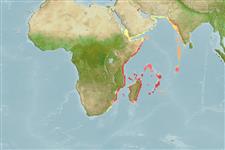Teleostei (teleosts) >
Syngnathiformes (Pipefishes and seahorses) >
Syngnathidae (Pipefishes and seahorses) > Syngnathinae
Etymology: Hippocampus: Greek, ippos = horse + Greek,kampe = curvature (Ref. 45335).
More on author: Duméril.
Issue
This species is considered as a synonym of Hippocampus kuda Weber, 1913 according to Lourie et al., 2016 (Ref. 115213); but was validated by Stiller et al., 2022 (Ref. 127687, 128218).
Environment: milieu / climate zone / depth range / distribution range
Ecology
Marine; demersal; non-migratory; depth range ? - 60 m (Ref. 52034). Tropical
Western Indian Ocean: Mauritius, Reunion, and east coast of southern Africa. Conservation status: Vulnerable (Ref. 30915).
Length at first maturity / Size / Weight / Age
Maturity: Lm 8.0 range ? - ? cm
Max length : 14.0 cm OT male/unsexed; (Ref. 30915)
Short description
Identification keys | Morphology | Morphometrics
Length type is height (=TL - head length). Found in seagrass beds. Ovoviviparous (Ref. 205). The male carries the eggs in a brood pouch which is found under the tail (Ref. 205).
Life cycle and mating behavior
Maturity | Reproduction | Spawning | Eggs | Fecundity | Larvae
Male carries the eggs in a brood pouch (Ref. 205).
Stiller, J., G. Short, H. Hamilton, N. Saarman, S. Longo, P. Wainwright, G.W. Rouse and W.B. Simison, 2022. Phylogenomic analysis of Syngnathidae reveals novel relationships, origins of endemic diversity and variable diversification rates. BMC Biology 20 (art. 75):1-22. [New family-group names in Additional file 1.] (Ref. 127687)
IUCN Red List Status (Ref. 130435: Version 2024-2)
Threat to humans
Harmless
Human uses
Fisheries: of potential interest
Tools
Special reports
Download XML
Internet sources
Estimates based on models
Preferred temperature (Ref.
123201): 24.8 - 27.5, mean 26.7 °C (based on 64 cells).
Phylogenetic diversity index (Ref.
82804): PD
50 = 0.5000 [Uniqueness, from 0.5 = low to 2.0 = high].
Bayesian length-weight: a=0.00447 (0.00175 - 0.01142), b=2.99 (2.77 - 3.21), in cm total length, based on LWR estimates for this (Sub)family-body shape (Ref.
93245).
Trophic level (Ref.
69278): 3.4 ±0.5 se; based on size and trophs of closest relatives
Resilience (Ref.
120179): High, minimum population doubling time less than 15 months (Preliminary K or Fecundity.).
Fishing Vulnerability (Ref.
59153): Low vulnerability (10 of 100).
